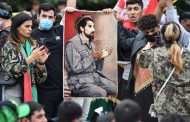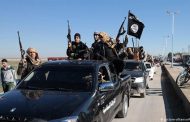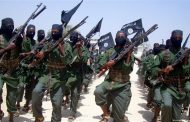U.S. sanctions on Iran have battered the country’s economy, causing unemployment to soar and its currency to plummet, which has helped stoke public unrest in recent years.
Still, Iranian officials say the country’s economy is resilient and would survive even if talks collapse with the U.S. and other world powers to revive the 2015 nuclear deal and grant Iran sanctions relief.
As Iran reconvenes with those nations in Vienna, it has taken an increasingly hard line, despite newly elected President Ebrahim Raisi facing new protests at home from Iranians demanding better economic prospects.
Many of Iran’s economic woes are due to years of mismanagement and corruption under consecutive governments. Its challenges grew multifold after the Trump administration left the nuclear deal in 2018 and imposed harsh sanctions on the country.
Iran’s economic output has suffered. Its GDP per capita halved from when the Trump administration withdrew from the nuclear deal and reimposed sanctions to last year, according to the World Bank. Inflation has risen. Iran’s currency, the rial, dropped sharply since last week in reaction to a deadlock in the nuclear talks, trading around an all-time low level. The World Bank expects Iran’s public debt to surpass 50% of GDP this year.
Burdened with these problems, Iran’s economy is unlikely to sustain years of continued sanctions without facing more dislocations, analysts say.
“I have a hard time seeing that not resulting in protests and increasing pressure on the government to do something,” said Henry Rome, a director covering global macro politics and Iran at Eurasia Group. “And the government response to protests, we know, is violent,” Mr. Rome added.
Iranians have taken to the streets repeatedly in recent months, demanding better living conditions and building pressure on Mr. Raisi’s government to strike a deal that would free up billions of dollars in frozen Iranian assets abroad and open its banking system to international trade.
Senior U.S. officials have said the Biden administration is moving to tighten enforcement of sanctions against Iran as diplomatic efforts to restore the nuclear deal falter. They said the U.S. will send a top-level delegation next week to the United Arab Emirates, a top U.S. ally but also Iran’s second-largest trade partner and a conduit for Iran’s trade and financial transactions with other countries, to warn private firms and banks there that they “face extreme risk” if sanctioned trade continues.
Iran appears to be banking on the recent progress it has made in its nuclear program, from producing highly enriched uranium to advancing its work on centrifuges, to get better terms from the West. Tehran says it escalated its enrichment program, breaching many of the deal’s provisions, in response to the U.S. sanctions.
“They have convinced themselves that the JCPOA wasn’t worth it,” Mr. Rome said, using an acronym for the deal. “They underestimate the beneficial parts of the deal to the economy, and they overestimate significantly their ability to keep the lights on without it for an extended period of time.”
The 2015 deal lifted most international sanctions on Tehran in exchange for strict but temporary restrictions on Iran’s nuclear work. But it didn’t lead to the kind of major foreign investments in Iran that Tehran had hoped for. Some investors remained worried about the snap back of U.S. sanctions in case of any breaches of the deal’s terms, and others were deterred by bureaucratic hurdles.
Thousands of farmers and residents took to the streets in November in Isfahan in central Iran to protest severe water shortages they blamed on the government’s mismanagement. Security forces fired tear gas, rubber bullets and water cannons to disperse the crowds.
The protests encapsulate a deeper problem for Mr. Raisi, who has pledged to diversify Iran’s economy and create nearly two million jobs by March 2023 to help ease the country’s economic crisis.
Successive governments have diverted river water in Isfahan toward industrial projects to strengthen one major driver of employment in the country: domestic industry. But the water diversion has sapped the energy of another job creator, agriculture, which accounts for about 25% of jobs in Iran.
For Mr. Raisi’s jobs plan to succeed, his cash-strapped government would need sanctions relief and access to hard currency abroad, said Bijan Khajehpour, an Iranian economist.
“It will be very far-fetched that the new jobs would be generated by government investments,” said Mr. Khajehpour, who is the managing partner at Vienna-based consulting firm Eurasian Nexus Partners.
The water protests followed a wave of unrest across the country. Thousands of workers at government-owned petrochemical plants in southern Iran went on strike in June, demanding better wages and improved working conditions.
A string of protests in 2019 and 2020, nicknamed Bloody November, was triggered by a hike in fuel prices and ballooned into broader calls, among some protesters, to topple the entire ruling system. The protests only subsided after security forces killed hundreds of demonstrators.
The Iranian government has taken steps to boost the economy, encouraging local companies to produce the sorts of goods that Iran had long imported from abroad and offering discounts on its oil to buyers willing to circumvent U.S. sanctions.
Iran’s economy has rebounded slightly after contracting sharply immediately after the sanctions were reimposed. Its domestic industry has grown.
Tehran appears convinced that it can withstand continued sanctions. The government’s budget chief has said he is designing the budget for the next Iranian year based on an assumption that sanctions won’t be lifted.
Meanwhile, Iran’s negotiating team has doubled down on several demands Iran first made before negotiations started in the spring, walking back on the significant progress since agreeing on the steps needed to be taken by all the parties to restore the accord. That progress included closing the gap on some difficult issues such as which sanctions the U.S. would remove and the steps Iran would take to wind back its nuclear infrastructure and reduce its nuclear fuel stockpile.
At home, Iran lost 1.1 million jobs between 2019 and 2021, partly due to the Covid-19 pandemic, the Statistical Center of Iran reported in May. The official unemployment rate is 9.6% but in addition, 1.4 million people—or 5%—have left the active workforce in one year, and aren’t counted in the statistics.
Mr. Raisi has called on the country’s private sector to lead the campaign to create jobs. In turn, some in Iran’s private sector urge the government to strike an agreement that would give them access foreign investments and markets.
“There is a win in it for us,” said Fariborz Naserinejad, the chairman of Tavsegal, a company that produces dialysis water-treatment systems for hospitals. His company has lost more than half its customers since 2018.








































admin in: How the Muslim Brotherhood betrayed Saudi Arabia?
Great article with insight ...
https://www.viagrapascherfr.com/achat-sildenafil-pfizer-tarif/ in: Cross-region cooperation between anti-terrorism agencies needed
Hello there, just became aware of your blog through Google, and found ...